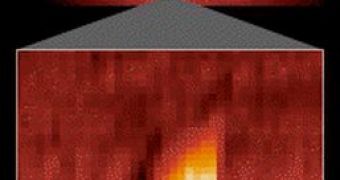Researchers analyzing data transmitted from the NASA Ulysses spacecraft were confronted with a surprise: the Sun's south pole is warmer than its North Pole.
Ulysses is the only spacecraft that has flown over the sun's poles, due to its uniquely-tilted orbit.
Its first polar flybys in 1994 and 1995 showed "a 7 to 8 % difference in temperature," said George Gloeckler of the University of Maryland, principal investigator of the Ulysses' Solar Wind Ion Composition Spectrometer (SWICS).
Scientists were puzzled and the Ulysses' return to the Sun's South Pole in 2007 just reconfirmed this. "Recent observations show that the average temperature ... is virtually identical to what we saw 12 years ago," said Gloeckler.
Of course, the sun's temperature can not be measured with a thermometer, but only investigating the solar wind at a safe distance of 300 million km employing the SWICS. "We measure the abundance of two oxygen ions found in the solar wind. The ratio O6+/O7+ tells us the temperature of the gas," explains Gloeckler.
The data registered by SWICS of the sun's polar wind is about one million degrees C, while on the other the wind is about 80,000 degrees cooler. Thus, polar conditions on the Sun's surface must be different. "The solar wind comes from the poles. The sun's magnetic field opens up over the poles and allows some of the sun's atmosphere to escape. Perhaps the structure of the sun's atmosphere over the two poles is different," explains Arik Posner, Ulysses Program Scientist at NASA headquarters.
The openings are named "coronal holes," and the hot atmosphere that escapes represents the solar wind. On the Earth, too, the stratosphere over the South Pole is colder, on average, than the stratosphere over the North Pole, due to the uneven distribution of land masses on Earth (most land is in the north) and complicated air circulation models. On the Sun, magnetism is the culpable, as the "cool spot" on the Sun matches the flips of the north magnetic pole. "The sun's magnetic poles have reversed polarity since the 1994 flyby?an effect of the 11-year sunspot cycle. The temperature asymmetry has also reversed. So it appears to be a magnetic phenomenon", notes Posner.
Photo credit: NASA

 14 DAY TRIAL //
14 DAY TRIAL //